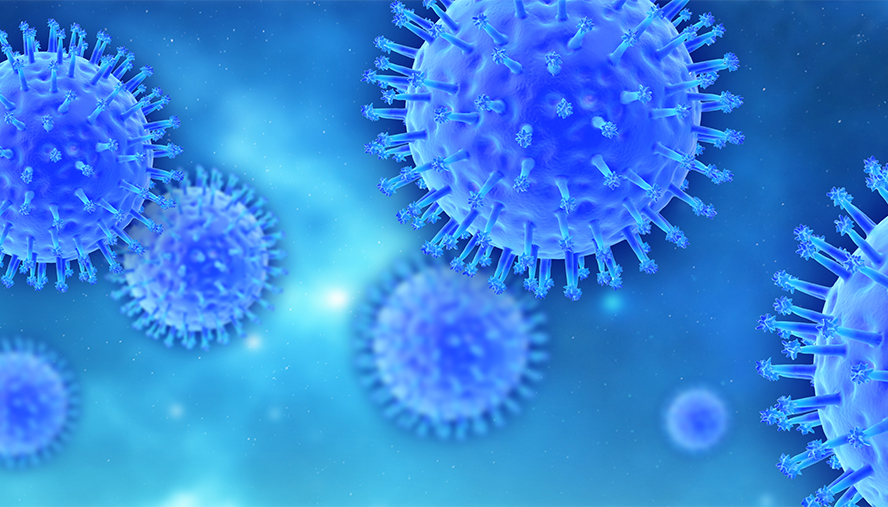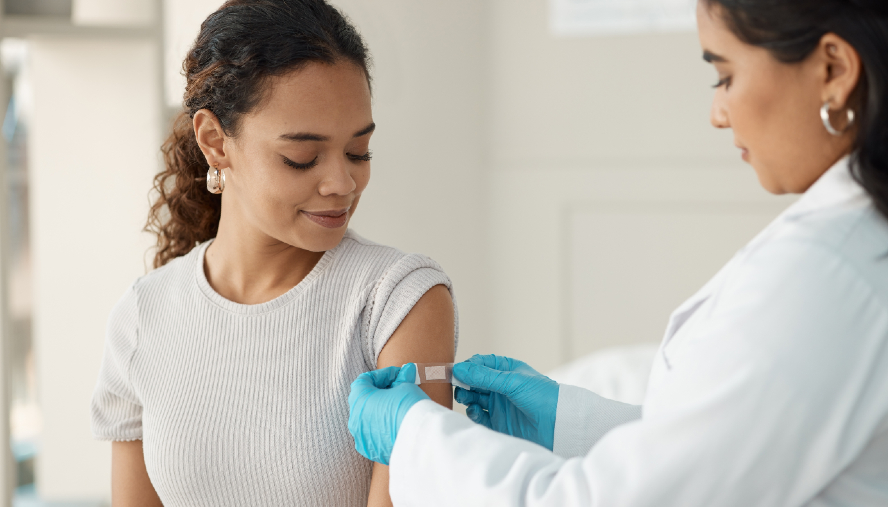 A Series of Articles on the Science Behind COVID-19
A Series of Articles on the Science Behind COVID-19
The (Other) Deadly Virus
By: Ahmad M. Rashid, MD, pulmonary and critical care physician, National Jewish Health
September 14, 2020

As the leaves change color and the mornings become crisp, an old nemesis of mankind makes a comeback— the flu.
Influenza is a virus that has been around a while, making people sick before “virus” was a known entity. Every year millions around the world get sick with this virus, and thousands die.
This year as we grapple with COVID 19, it is important refresh our knowledge about the flu and how you can protect yourself from both diseases.
What is influenza?
Influenza is an RNA virus that belongs to a different family of viruses than the coronavirus. RNA stands for ribonucleic acid. It delivers genetic instructions to the cell to help the virus multiply in the body.
There are four different types of influenza viruses-but human infections are mostly caused by Influenza A and B. The flu virus primarily attacks the respiratory system, starting off in the cells lining your nose and mouth, and then quickly making it to the lungs. In vulnerable individuals, this virus can cause a nasty case of pneumonia.
Influenza is a tricky customer that keeps on evolving ever so slightly each season. This prohibits the human immune system from forming a “lasting memory” of the virus so there is no ready defense once the new strain shows up.
The symptoms can range between mild congestion in nose and sinuses, with low fever, and body aches-to full blown pneumonia and respiratory failure and shock.
So how bad is the flu?
There is no doubt that this disease causes a LOT of damage around the globe. Given the widespread nature of the disease and variability in data reporting, true estimates of disease burden are difficult to get. According to ESTIMATES published by organizations such as the World Health Organization and the Centers for Disease Control and Prevention (CDC), show that annually 200,000 to 500,000 people around the world die as a result of influenza and related diseases. Closer to home, the CDC estimated about half a million Americans required hospitalization and about 34,000 of those died due to influenza and related diseases during 2018-2019 flu season.
When is flu season?
The flu virus is present and circulating all through the year, but the activity and disease peak during fall and winter, when people stay indoors, and there is not a lot of fresh air ventilation. In US, December to February are historically months with peak flu activity. Flu season in Southern Hemisphere is typically April through September.
How does one catch flu?
The disease spreads from person to person. When an infected person coughs, sneezes and talks, droplets full of the virus settle in the noses and mouths of nearby people, and infect them. Less often, you can get the flu by touching an infected surface with your hands and then touching your mouth, nose or eyes.
People are contagious from about 24 hours before and 2-3 days after the start of flu symptoms.
Who is at higher risk of getting sick?
- People over 65
- People with chronic diseases such as diabetes
- People with chronic respiratory diseases, including asthma and COPD
- Pregnant women
- People with weakened immune systems
How can you protect yourself from getting the flu?
The same steps that protect you from COVID-19, help protect you against the flu:
COVID & FluWhen the COVID-19 pandemic began in the US, it overlapped with the end of the flu season. Although testing for COVID-19 was just emerging, it became clear that one in five people had both the flu virus and the COVID-19 virus. There is active research to understand if and how one virus influences infection with the other. Since the symptoms of flu and COVID can be quite the same, the only way to tell them apart and receive the best treatment is to get tested! The technology is so advanced, that the results are available within 24 hours.
Flu Shots in the Time of COVIDCan flu vaccines make one more prone to catch COVID-19?There has been some concern that if you get a flu shot, you will become more prone to getting infections with other respiratory viruses-and especially other coronaviruses. Although some small studies have pointed towards this, most large population-based studies in last five years DO NOT support this hypothesis. It is prudent, at least until we know more, that people who currently have severe COVID-19 symptoms should not get the flu vaccine. For those who have tested positive for COVID-19 and have no symptoms or mild symptoms, it is probably okay to get the vaccine ONLY AFTER THEY ARE DONE WITH THE RECOMMENDED ISOLATION PERIOD. Since the science of COVID-19 and influenza is rapidly emerging, it is best to check with your physician IF and WHEN to get flu vaccine if you had COVID-19.
What is different this year?There is new variety of high dose vaccines available for the 2020-2021 flu season that cover more viral strains. The health care providers will be extra cautious, and there will be more screening than usual. You will be asked questions about experiencing symptoms of COVID 19. |
- Avoid contact with people if you are sick
- Cover your cough, sneeze
- Avoid large indoor gatherings, in places with poor ventilation
- Wash your hands or use sanitizer frequently
- Clean, disinfect, exercise, rest, keep yourself hydrated
How were influenza vaccines developed?
 Fortunately, unlike our current nemesis, we do have effective vaccines against influenza. Influenza vaccines have been in use for U.S. military and civilians since 1945. The vaccines have undergone rigorous safety checks and improvements in the last 75 years.
Fortunately, unlike our current nemesis, we do have effective vaccines against influenza. Influenza vaccines have been in use for U.S. military and civilians since 1945. The vaccines have undergone rigorous safety checks and improvements in the last 75 years.
Since the flu virus mutates frequently, each year a global group of very smart virologists, study the viral strains from around the world. They use complex computer algorithms, to predict which types of strains will cause disease in the coming flu season. The Federal Drug Administration then approves the vaccines against those strains each spring. The mass production starts in summer so that the vaccines will be available at your pharmacy or physician’s office by fall.
How do the vaccines work?
The inactivated viruses in the vaccines prime your immune system, causing it to form a memory against the virus. If you get exposed to the real virus later, the immune system quickly shifts into high gear, producing killer cells and antibodies that can nip the infection in the bud, before it can cause severe damage.
But do vaccines work?
Various organizations around the world have tested the effectiveness of these vaccines over the years by monitoring thousands of people who get the shots, to see if they get the virus.
Depending on the strain of virus circulating in a year, the vaccines have an efficacy of upwards of 50 percent, and in some instances up to 77 percent. Elaborate models show that mass vaccination reduces the influenza infection by 40-60 percent in the general population.
Are flu vaccines safe?
In the 75 years that people have been using these vaccines, remarkably few serious side-effects have been reported. Pain, slight fever, and body aches are the most common side effects. If you are allergic to eggs-there are “eggless” vaccines now available. Guillain-Barre syndrome (GBS), is a rare disease that affects the nervous system, and causes paralysis. GBS is linked is linked to a vaccine that was prepared in 1976-to deal with swine flu epidemic at that time. Since then, despite the ongoing fears, the risk of someone getting GBS after getting a flu vaccine has been shown to be miniscule. Something like one in a million or less. In fact, you have more chances of getting GBS after getting the flu!
There are so many vaccines-which is the right one?
- Ages six months to 65 years, in good health or pregnant— “Standard Flu Vaccine”
- Older than 65 — “High Dose Flu Vaccine”
- Older than 18 years and allergic to eggs — “Egg Free Vaccine”
- Ages 2-49 years, healthy, non-pregnant — “Nasal Spray Vaccine” (this has live, weakened virus, so talk with your physician before getting this vaccine)
Don’t we have medications to treat influenza?
There are currently four antivirals approved for treating Influenza. All of these work best if the medications are started within two days of the first symptoms, although doctors administer them even after that period of time for individuals with severe flu disease who need hospitalization. Antivirals can decrease the duration of flu symptoms.
Influenza pandemics and epidemics have ravaged human societies and have changed the course of history in the not too distant past. During these times, when all our lives have been impacted by yet another pandemic, it is even more important to pay attention to our health and the health of those around us.
Get vaccinated and stay safe!
| The information on our website is medically reviewed and accurate at the time of publication. Due to the changing nature of the COVID-19 pandemic, information may have since changed. CDC.gov and your state’s health department may offer additional guidance. |




